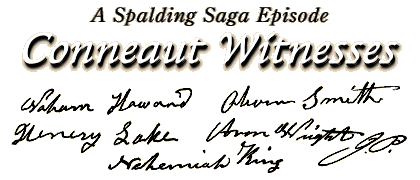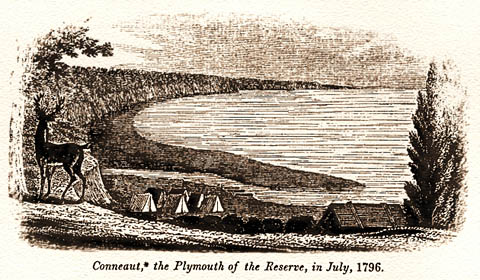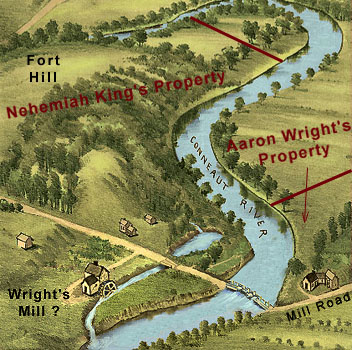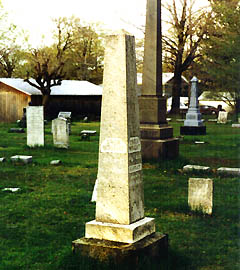- THE SPALDING RESEARCH PROJECT -
Back to Conneaut Witnesses Index Page


The Hon. Aaron Wright (1775-1853)

The Hon. Aaron Wright's Former Lands in Conneaut, Ashtabula Co., Ohio
The red block was Wright's parcel at the west end of the village, as it was in 1820
The yellow, purple, green, and blue lands belonged respectively (c. 1812-1820) to
Messrs. Henry Lake, Nehemiah King, Nahum Howard and Solomon Spalding.
Wright's 1841 History | Wright's Docket Book | Lake Family Bible | Conneaut Giants
|
HAD Aaron Wright been just a little more wealthy and ambitious his name might have easily gone down in the history books as the Father of Conneaut, or even of Ashtabula, the county in Ohio where that town is located. But even without the fame commonly associated with wealth and power, the Hon. Aaron Wright deserves a place in the memories of the people of northern Ohio. He was among the handful of American men and women who set foot on the southern shores of Lake Erie after that land passed from the Indians into the hands of settlers of European ancestry, and -- more important than that -- he was among the half dozen who remained there to build a home for himself and future generations. According to the Enclopedia Britannica's article on Conneaut, the place is a "city" in "Ashtabula county, extreme northeastern Ohio, U.S. It lies along Lake Erie at the mouth of Conneaut Creek and is adjacent to the Pennsylvania border (east)... The harbour site was permanently settled in 1799 by Thomas Montgomery and Aaron Wright." Most historical accounts place the date of Montgomery's and Wright's first arrival in Ohio as 1798. They had intended to join the little company then at Harper's Landing (now Madison), but decided to settle at Conneaut Creek when they found an abandoned surveyors' cabin there. Wright related in 1841 (in a dictated statement, "Sketch of the Early History of Conneaut, Ashtabula County, Ohio, as Related by Aaron Wright, Esq.") that he and Thomas Montgomery first visited Conneaut Creek harbor in 1798. They went back to Delaware Co., New York to gather the necessary provisions and then returned to settle in Ohio during the spring of 1799. The first settlers at Conneaught Creek included the Thomas Montgomery family, Aaron Wright, Robert Montgomery and family, Levi and John Montgomery, Nathan and John King, and Samuel Bemus. Most or all of these pioneers came from Harpersfield, Delaware Co., New York. Aaron Wright traveled with Thomas Montgomery to Ohio, where Aaron (he generally spelled his name "Aron") lived before 1798, and what his ancestry was, available accounts do not tell. When the two-family settlement on the creek first began did not even have a name, much less any of the conveniences of civilization. It was originally the site of the Western Reserve surveyors' base camp, from which those hardy pathfinders operated in laying out the divisions of Richfield and the other townships of old Trumbull County. But by about 1800 the pioneers gave their tiny settlement at the mouth of Conneaut Creek the name of "New Salem." With the formation of Geauga County in 1804, the northeastern part of the county (section 1 west, ranges 1 & 2 north) became "Salem" township and henceforth the growing settlement was set down on the maps as "Salem" village (often called "New Salem"). In 1834 it was incorporated as "Conneaut," the name it has borne ever since.
When new immigrants to the Western Reserve arrived during the summer of 1799 they found only two spots inhabited by American settlers: Harper's Landing (at the mouth of Cunningham Creek, later called Madison Dock) and Conneaut Creek harbor, where Aaron Wright and the Montgomery family were building their new homes. According to the 1878 History of Ashtabula, Aaron Wright built the second permanent residence at New Salem -- no doubt a simple, rough-hewn, log cabin in which he could take shelter from the storms of the winter of 1799-1800. The same 1878 account says that this cabin was located "on the then Ridge road, what is now Liberty street, in the village, on the present site of Geo. W. Cummings' residence." This spot was apparently at or near the intersection of Wrights Ave. and Liberty St., a short distance west of where Route 7 now enters the southern limits of Conneaut. Aaron Wright's Marriage and Family The distinction between the Wright and Montgomery families was removed shortly after the parties settled New Salem. According to page 157 in the 1878 History, "The first marriage among the settlers occurred in 1800, Aaron Wright and Anna Montgomery being the contracting parties. They were married in Harpersfield, Justice Wheeler performing the ceremony." The genealogical entries in the Lake family Bible add to this the fact that "Aaron Wright was married to Anna Montgomery the 12th day of March A.D. 1800." She was the daughter of Robert Montgomery (1741-1822, a cousin of Thomas Montgomery) and was born on Aug. 13, 1786 in Blandford, Hampden, Massachusetts. According to the Lake Bible, "Mrs. Anna Wright, wife of Aaron Wright died Tuesday Jan. 25, 1857 aged 72 years." If the youthful Aaron Wright's marriage to a girl of 14 seems highly unusual by today's standards, it might be recalled that she was practically the only available unmarried female in northern Ohio at the time; that Aaron had recently rescued her when she was lost, probably saving her life; that theirs was the first marriage of settlers on the Western Reserve; and that the union lasted nearly 57 years, producing at least 3 children: Amelia (born 3 Dec. 3, 1801, died early), (Harriet born July 28, 1805, died Sept. 30, 1878), and Orrin (born c. 1815, died after 1853). According to Wright's 1853 obituary, he died "in the 79th year of his age," on Nov. 10, 1853, "leaving behind him to mourn his loss a widow and two children..." Aaron Wright's Work at New Salem After completing his house in 1799 and getting married the following year, Aaron Wright's thoughts turned to the problem of producing food in the wilderness. The soil and climate in the Conneaut region were sufficient to produce crops of wheat and maize, but it was difficult for the pioneers to prepare food from these staples, unless the wheat was soaked and boiled into an unpalatable mush and the corn was eaten before its kernels hardened. In order to make bread, cakes, and other frontier edibles the grain need to be ground in a mill and turned into flour. Hand-mills, although they might be useful in a pinch, were not a practical means to turn entire harvests into flour. Like the settlers in all the new villages in the wilderness, the farmers of New Salem were soon in need of a grist mill. Wright says in his 1841 account that before the year 1808, the Conneaut area settlers (living along the creek on both sides of the Ohio-Pennsylvania line) had to carry their bags of harvested grain to the nearest flouring mill, then located in Elk Creek, Pennsylva nia. As the crow flies, this was about 13 miles from New Salem, but on the narrow and overgrown wilderness trails of that time, the round trip could add up to more than 32 miles and take several days. Wright's account says: "I have often carried a bushel and a half of wheat on my back to this mill, and if on my return my provisions failed, I struck a fire, dropped some water in the mouth of my bag with my hands, and mixed my bread, and then spread it on a basswood bark, brought for the purpose, and baked it before the fire." Constructing a grist mill from scratch, many miles from civilization, was no easy task in those days. Luckily the Conneaut pioneers had ready access to Lake Erie and heavy machinery could be shipped in from Buffalo. In 1806 Aaron Wright (probably backed financially by a few of his neighbors) began the long and laborious process of constructing a mill at New Salem, on the banks of Conneaut Creek. While the settlers were awaiting the erection of the mill, they had plenty of work at hand, just in clearing the heavily forested land for farms, dwellings, and roads. By land, through the dense undergrowth, it was difficult to travel by foot or on horseback, and journeys in a wagon were still a dream for the future. Aaron Wright provides some sense of New Salem's isolation in one passage, taken from his 1841 account: "I once lived sixteen days without seeing a human face, except my own in a pail of water which I used for a looking glass, when compelled to shave." With the help of sturdy neighbors like Seth Harrington and the King brothers (Nathan and Nehemiah, the latter of whom passessed skills in surveying), Aaron Wright was able to open a serviceable roadway, connecting New Salem with what is now Ashtabula. This road (modern U.S. Route 20 follows its path) was later pushed west to Harpersfield and Painesville and quickly became the major line of communications and commerce across northern Ohio. Passing through New Salem, it became the "Old Man Road," which passed along the east-west ridge of high ground, crossing Conneaut Creek, the State line, and connecting to Presque Isle (Erie, Pennsylvania) and points eastward. Once men on horseback could make their way through the wilderness, the residents of New Salem found that they had a few visitors, as well as more newcomers, ready to build houses and clear more farmland. The famous Rev. Joseph Badger came through in 1802 or '03, and conducted the first known religious services in that region -- in the home of Aaron and Anna Wright. Although he never joined any particular church, the 1853 reporter says of him: "his assistance was never withheld in promoting the cause of the Church, and Ministers and laymen always met a cheerful reception and a hospitable entertainment at his board. When the country was new and an almost unbroken wilderness, his house was opened for religious meetings, and as often his services and time was tendered in inviting his far distant neighbors to assemble under his roof to listen to the Gospel from some Missionary who then visited this section at regular intervals." The writers of the 2000 CD-ROM book, The Spalding Enigma, point out the interesting fact that this same Western Reserve missionary, Rev. Joseph Badger, "according to his own journal... visited Cherry Valley, [Otsego Co.], New York, in 1802" (apparently on his way back to Ohio from a journey to Massachusetts) and, that since the Rev. Solomon Spalding was living in or near that place "at that time," that it might be "reasonably inferred" by the modern reader that these two gentlemen met at that time. At the very least, the 1802 visit of Rev. Badger to Cherry Valley shows how communications were beginning to open up between the remote Western Reserve and the more settled eastern towns. Soon whole families from Otsego Co., (like the Spaldings, the Jacksons and the Rudds) were moving off to Ohio, intent on becoming Aaron Wright's new neighbors. Aaron Wright Completes his Mill at New Salem The 1878 History records that "Aaron Wright erected the first grist-mill in the township in 1806-8, on the present site of Mr. Rathbone's mill." Whether this was on the north or south bank of the creek the historian does not say. Since the southernmost corner of Wright's property seems to have ended a few hundred feet south of the creek (along the border between ranges 1 and 2), he may have built his grist mill just south of where Mill Road crosses Conneaut Creek. See the map below for a possible reconstruction of the site, with the later bridge and a few buildings erased from the 1896 panoramic map.
In an on-line series of articles by Darlene E. Kelley, entitled "And Then They Went West," Ms. Kelley says that the first surveyors on Conneaut Creek discovered a group of Indians living beside a spring "near the "lower rapids'" of the watercourse. At this spot, she continues, "a dam was built" to enable the erection of "the first grist mill of the region." Kelley's information may not be entirely accurate, but a dammed up spring near the creek bank would certainly provide a good location for a pond and grist mill. The USGS topographic maps of Conneaut show a swampy depression at the exact location indicated on the above pictured reconstruction of Aaron Wright's mill pond and the 1896 panoramic map shows a short stream bed following the same line as the reconstructed mill race. Probably this is the spot where Wright's grist mill was finished in 1808. Aaron Wright's 1808 completion of his grist mill marked a turning point in New Salem's history. Not only was it the first encroachment of the American Industrial Revolution into northeastern Ohio, Wright's successful construction and operation of the mill demonstrated that such heavy machinery could be assembled on the frontier and put to work to turn a profit for its owner. It was only a matter of time before other would-be industrial entrepreneurs followed in the tracks he had laid down. Probably the first of these was a land speculator from Otsego Co., New York, Solomon Spalding. Spalding had visited the Western Reserve briefly in 1803, to finalize his purchase of some lots on the east bank of the creek. In 1806 he was back in New Salem again, unloading some of these same lots to the new settlers. Aaron Wright was just commencing work on his grist mill when Spalding visited the town and Wright's dreams of waterwheels and gear-works may have also taken root in the mind of the eastern visitor. It was likely then that Solomon decided to return to his land on the banks of Conneaut Creek -- and there to build a house for his family and a water-powered enterprise of his own. He did not permanently move to the Western Reserve until 1809, but when he came he brought the plans and equipment for an iron forge, complete with a water-wheel driven trip-hammer. Aaron Wright, in 1833, recalled his first encounter with Solomon Spalding with these words: "I first became acquainted with Solomon Spalding in 1808 or 9, when he commenced building a forge on Conneaut creek." Aaron Wright's interest in Spalding's "forge on Conneaut creek" may have been something more than that of a disinterested observer. After making a mill pond and attempting to put his forge into operation, Spalding wrote up an agreement in about 1810 between himself and two other local residents, giving them the "priv[lege] to erect [a] Mill" on his property, in return for their doing part of the work "of keeping [the mill pond] dam in repair." Without any explanation this agreement also says that "Wright has prefer[ence]... to take out w[ater] for himself." These words appear to be speaking of Aaron Wright having the preeminent privilege of water rights at Spalding's mill pond. It is highly unlikely that Spalding was referring to the pond upon which Wright completed his grist mill in 1808, so this reference must be to some other water-powered project envisioned or carried out by Mr. Wright. Spalding's forge, like Wright's mill, was constructed just above a ford on Conneaut Creek, the difference being that Spalding's enterprise was located at New Salem's eastern doorway, while Wright's grinding business was situated at the village's southern entry point. Did Aaron Wright build another water-mill close to Spalding's pond? If he did the local historians have failed to preserve that particular memory. This secondary mill location, in close proximity to Spalding's iron forge, would not have been an entirely unreasonable possibility. Spalding's c. 1810 water agreement indicates that there was enough water and land available for the operation of more than one factory below his mill pond. Besides that fact, it might be significant to note that the owner of the land immediately adjacent to Spalding's 26 acre plot, on the north side of Main Road, belonged to Wright's brother-in-law, James A Harper. Actually, it is possible that the dammed up spring previously mentioned by Darlene E. Kelley was the one on Spalding's land and not the one operated by Aaron Wright a few miles upstream. Spalding's location seems to agree somewhat better with Kelley's reference to the "lower rapids" on the creek. According to Abner Jackson, Spalding's operation was located much closer to the creek mouth than was the location reconstructed for Wright's grist mill. Jackson, writing in 1880, says: "Spaulding... moved to Conneaut, Ashtabula County, Ohio, and built a forge on Conneaut Creek, two miles from Conneaut Harbor and two miles from the State line." Aaron Wright's Relationship with Henry Lake's Family From the very first mention of their respective names in Eber D. Howe's 1834 book, Mormonism Unvailed, the stories of Aaron Wright and Henry Lake seem to have become irrevocably intertwined.
(this section is under construction)
xxxxx xxxxx xx xxxxx x xxxxxxx xx xxxx x xxxxxx x x xxxxxxx x xxxxx xxxxx xx xxxx xx xx xx xxxxxx xx xxxx x xxxx xxx xxxx x x xxxxxx xx xxxxxx xx xxxx x xxxx xxx xxxx x x xxxxxxx x xxxxx xxxxx xx xxxxx x xxxxx xxxxx x x xxxxxxx x xxxxx xxxxx xx xxxx xx xx xx xxxxxx xx xxxx x xxxx xxx xx xxx xxxx x x xxxxxx xx xxxxxx xx xxxx x xxxx xxx xxxx x x xxxxxxx x xxxxx xxxxx xx xxxxx x xxxxx xxxxx x x xxxxxxx x xxxxx xxxxx xx xxxx xx xx xx xxxxxx xx xxxx x xxxx xxx xxxx x x xxxxxx xx xxxxxx xx xxxx x xxxx xxx xxxx x x xxxxxxx x xxxxx xxxxx xx xxxxx x xxxxxxx xxxxxxx x xxxxx xxxxx xx xxxxx x xxxxxxx xxx xx xxxx x xxxx xxx xxxx x x xxxxxxx x xxxxx xxxxx xx xxxxx x xxxxx xxxxx x x xxxxxxxx xxxx x x xxxxxx xx xxxxxx xx xxxx x xxxx xxx xxxx x x xxxxxxx x xxxxx xxxxx xx xxxxx x xxxxx xxxxx x x xxxxxxx x xxxxx xxxxx xx xxxx xx xx xx xxxxxx xx xxxx x xxxx xxx xx xxx xxxx x x xxxxxx xx xxxxxx xx xxxx x xxxx xxx xxxx x x xxxxxxx x xxxxx xxxxx xx xxxxx x xxxxx xxxxx x x xxxxxxx x xxxxx xxxxx xx xxxx xx xx xx xxxxxx xx xxxx x xxxx xxx xxxxx x xxxxx xxxxx xx xxxx xxxx x x xxxxxx xx xxxxxx xx xxxx x xxxx xxx xxxx x x xxxxxxx x xxxxx xxxxx xx xxxxx x xxxxx xxxxx x x xxxxxxx x xxxxx xxxxx xx xxxx xx xx xx xxxxxx xx xxxx x xxxx xxx xx xxx xxxx x x xxxxxx xx xxxxxx xx xxxx x xxxx xxx xxxx x x xxxxxxx x xxxxx xxxxx xx xxxxx x xxxxx xxxxx x x xxxxxxx x xxxxx xxxxx xx xxxx xx xx xx xxxxxx xx xxxx x xxxx xxx xxxxxx xx xx xx xxxxxx xx xxxx x xxxx xxx xx xxx xxxx x x xxxxxx xx xxxxxx xxxx xxxx x x xxxxxx xx xxxxxx xx xxxx x xxxx xxx xxxx x x xxxxxxx x xxxxx xxxxx xx xxxxx x xxxxx xxxxx x x xxxxxxx x xxxxx xxxxx xx xxxx xx xx xx xxxxxx xx xxxx x xxxx xxx xx xxx xxxx x x xxxxxx xx xxxxxx xx xxxx x xxxx xxx xxxx x x xxxxxxx x xxxxx xxxxx xx xxxxx x xxxxx xxxxx x x xxxxxxx x xxxxx xxxxx xx xxxx xx xx xx xxxxxx xx xxxx x xxxx xxx xxxx xxxx x xxxx xxx xxxx x x xxxxxxx x xxxxx xxxxx xx xxxxx x xxxxx xxxxx x x xxxxxxx x xxxxx xxxxx xx xxxx xx xx xx xxxxxx xx xxxx x xxxx xxx xxxx x x xxxx .
(this section is under construction)
xxxxxx xxxxx xxxxxx xxxx x xxxxx xxxxxx xxxx x xxxxxx xxxx xxx x xxx xxxxxx xxxx xxx xxxx xxx x xxx xxxxxx xxxxx xxxxxx xxxx x xxxxx xxxxxx xxxx x xxxxxx xxxx xxx x xxx xxxxxx xxxx xxx xxxx xxx x xxx xxxx xxx x xxx xxxxxxx xxxx xx xxxxxx xxxx x xxxxxx xxxx xxx x xxx xxxxxx xxxx xxxx xxxx xxxxxx xxxx x xxxxx xxxx xxx x xxx xxxxxxx xxxx x xxxxxx xxxx xxx x xxx xxxxxx xxxx xxx xxxx xxx x xxx xxxxxx xxxx x xxxxxxxxx xxxxx xxxxxx xxxx x xxxxx xxxxxx xxxx x xxxxxx xxxx xxx x xxx xxxxxx xxxx xxx xxxx xxx x xxx xxxx xxx x xxx xxxxxxx xxxx xx xxxxxx xxxx x xxxxxx xxxx xxx x xxx xxxxxx xxxx xxxx xxxx xxxxxx xxxx x xxxxx xxxx xxx x xxx xxxxxxx xxxx x xxxxxx xxxx xxx x xxx xxxxxx xxxx xxx xxxx xxx x xxx xxxxxx xxxxxxxxx xxxxx xxxxxx xxxx x xxxxx xxxxxx xxxx x xxxxxx xxxx xxx x xxx xxxxxx xxxx xxx xxxx xxx x xxx xxxx xxx x xxx xxxxxxx xxxx xx xxxxxx xxxx x xxxxxx xxxx xxx x xxx xxxxxx xxxx xxxx xxxx xxxxxx xxxx x xxxxx xxxx xxx x xxx xxxxxxx xxxx x xxxxxx xxxx xxx x xxx xxxxxx xxxx xxx xxxx xxx x xxx xxxxxx |
|
(Taken from a typed copy of the original, now in The Ashtabula Co. Historical Society, Geneva, Ohio.) Aaron Wright's 1841 Historical Sketch
SKETCH OF THE EARLY HISTORY OF CONNEAUT, The "Mannasaugas," a small tribe of Indians, possessed the country until 1796-7, and it was quite certain that their headquarters were, where Conneaut Village now stands. Five huts were standing where the "Mansion House" is erected, in 1798, and a little northeast of the present site of the Presbyterian Church, between it and the Ridge road, was an extensive Burying Ground, laid out in lots with great regularity. There was but one small tree standing on the area of more than an acre. There must have been several hundred, and perhaps some thousands of graves. To satisfy myself, I opened a number of what appeared to be graves and found human bones in every instance. Either from age or some other cause, these bones soon crumbled to dust on exposing them to the atmosphere. What is now called Harmon's Island near the mouth of the Conneaut Creek, was cleared, and had been planted to corn. There were other clearings of less extent. The most remarkable Indian antiquity is "Fort Hill" in the form of a Delta, located a little below the center road on the southeastern side of the Creek, which now washes its Northern base. It is of the same height as the surrounding country, but cut off on the south and east by a ravine nearly of equal depth with the bed of the Creek -- This fort is very difficult of ascent, except at its eastern point of termination, where it is easy. It contains about four acres, and was covered with brushwood about six or eight feet high. It was inclosed by an embankment of earth about six feet high, with only one opening at its southern point and one on the northeast. It must once have been a fortification of no mean importance in Indian warfare. The Indians disappeared entirely in 1796 or 7, from the following occurrence, viz., -- A man travelling from Detroit to Erie, Pa., (then Presque-Isle) was killed by the Indians for the sake of two rifles which he possessed, and a small detachment of soldiers came up from Presque Isle to demand the murdered. "Bear's Oil" the Chief of the Mannasaugas" agreed to deliver him by a given day, but before the day arrived, the Indians all fled. The settlers never had any trouble from them. SETTLEMENT: The first permanent settlement was in the year 1799. Thomas Montgomery and myself visited it in 1798, and settled in the spring of 1799. Robert Montgomery and family, Levi and John Mt.Gomery, Nathan and John King, and Samuel Bemus and family, came the same season. All that now remained of these, in the township, are Samuel Bemus and myself and wife.James Harper, Seth Herrington and James Montgomery, came in 1800, with their families. No more came for some years. Two log cabins, built by the surveyors in 1796 or 7, one at the mouth of the creek and the other about half way to the present site of the village, were standing, and were occupied by the settlers. The first house built by settlers, was one by Nathan King on the Ridge Road where John Brown now lives, and the next was built by myself on the farm on the Ridge Road, where Chester Sandord now lives. I once lived sixteen days without seeing a human face, except my own in a pail of water which I used for a looking glass, when compelled to shave; and this was the extent of my toilette for a long time. A SOCIAL VISIT, ENTERTAINMENT: After my sixteen days exclusion, a friend called upon me, and of course I was anxious to receive him hospitably and entertain him in good style. My larder was wanting in one very important article, viz., meat -- the of my last porcupine having been already picked.While in this dilemma two other friends providentially called, and one of them had killed a fine turkey. I set him to stripping off the feathers, while I prepared my kettle and some dough, wherewith to make a "Pot Pie" by simply putting flour and water together. I soon got supper in readiness, and my friend has often informed me that it was the best meal of victuals to which he ever sat down, made of my "Pot Pie," Bread, Pepper and Salt. At bed time, I spread my straw bed upon the floor, as usual, and by lying crosswise, four of us enjoyed a comfortable night's rest. ORIGINAL NAME: The present County of Ashtabula was then called the Township of Richfield.PROVISIONS: We had always an abundance of grain, and for meat we ate Bear, Elk, Raccoon and Porcupine, which were abundant. MILLS: The nearest mill from 1799 to 1808 was sixteen miles, at Elk Creek, Pa., where I have often carried a bushel and a half of wheat on my back, and if on my return my provisions failed, I struck a fire, sipped some water into the mouth of my bag with my hands, and mixed my bread, and then spread it on a basswood bark pulled for the purpose, and baked it before my fire. I began a mill in 1808, and finished it in 1809 -- the first in the settlement. ROADS: There were no roads except "Indian Trails." The travel was upon the beach of the Lake, fording the streams with difficulty. In 1800, Nathan King, Seth Harrington and myself, marked the present Ridge Road to Ashtabula, west of the village, where we met the people from Harpersfield similarly engaged. We then began to cut the road, I was the first Supervisor, and my District extended from the State line to the "ten mile stake" at the forks of the road at Fobe's farm in Kingsville. COMMERCE: There was then no boats on the lake except four and six cared boats, owned principally by the settlers for their private accommodation. The first in our settlement was built by John Montgomery, just before the war of 1812. All the goods we procured, were from settlers who brought them in to exchange for provisions.SCHOOLS: Our houses were "Log Cabins" cobbed off covered with clap boards split out live staves (commonly called Gourd Seed Shingle) with puncheon floors. We used no nails nor iron of any kind.LAWS: For some time we were "a law unto ourselves." There was no necessity for them, except of the criminal order. The Government was a pure Democracy, and the proceedings of our Judiciary will give a tolerable idea of the method of trial, passing sentence and of administering punishment.One of the settlers sometimes misused his wife. On such occasion the Court assembled by common consent -- (Nathan King usually presiding), and the back of the offender was the only Record of their doings. The first Magistrate under the Territorial Government, was Noah Cowles of the Austinburg Settlement, and I was the first Constable in Richfield. The first Magistrate appointed in our settlement was James Harper, who declined serving, and Nathan King was appointed in his place. MAILS: The first mail ever brought into our settlement, was, I think in 1808, by John Metcalf, now of Ashtabula, on horseback. John Rudd was the first Postmaster.Six weeks from New York City to Conneaut was not very slow traveling in those times. The first carriage employed in the mail service was, I think, in 1811, by Anan Harmon. It was a rude sort of Dug Out, bearing about the same comparison to our present coaches, as our "Log Cabins" did to the best buildings of the present day. Its appearance, however, created as great an excitement as did the first Steam Boat on the Hudson River. and recorded May 1st, 1841. P. R. Spencer, Recording Secretary |
This web page and the episode links (below) are still under construction
Go to top of this page
Spalding Saga: intro | 01 | 02 | 03 | 04 | 05 | 06 | 07 | 08 | 09 | 10 | 11 | 12
Spalding Studies "Research" | Spalding Research Project | Special Collections
"Home" | Bookshelf | Mormon Classics | Newspapers | History Vault
Last Revised: Feb 1, 2003



